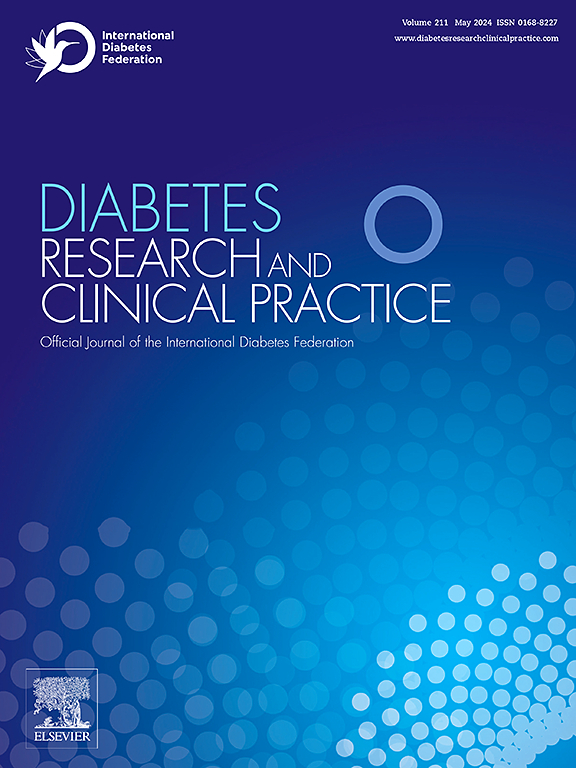早期2型糖尿病临床表现和药理学治疗中的教育不平等:一项丹麦患病率研究
IF 6.1
3区 医学
Q1 ENDOCRINOLOGY & METABOLISM
引用次数: 0
摘要
目的探讨教育程度如何影响2型糖尿病(T2D)诊断的临床表现和药物治疗。方法对10020名新近诊断为T2D的丹麦前瞻性DD2队列患者进行横断面分析。计算详细临床特征和药物治疗的性别和年龄校正患病率(aPRs)。结果低学历占31%,中等学历占50%,高等学历占19%。受教育程度低的个体比受教育程度高的个体更容易肥胖(58%比49%,aPR 1.20 [95% CI 1.14-1.28]);生活方式不健康(目前吸烟者:22% vs 15%, aPR 1.53 [1.32-1.76]);久坐活动水平:21% vs 15%, aPR 1.36 [1.20-1.55]);心血管并发症(23%比17%,PR为1.30[1.16-1.46])和微血管并发症(16%比13%,aPR为1.18[1.02-1.35])较多。低教育水平与较高的甘油三酯、更多的胰岛素抵抗和较差的肾功能相关,而HbA1c、血压和低密度脂蛋白胆固醇则相同。对心血管有益的药物和较新的保护器官的糖尿病药物的使用与受过高等教育的个体相似或更高。结论认识社会和教育因素对诊断时T2D表现的影响对改善治疗和预后至关重要。本文章由计算机程序翻译,如有差异,请以英文原文为准。
Educational inequalities in clinical presentation and pharmacological treatment of early type 2 diabetes: A Danish prevalence study
Aims
To examine how educational attainment impacts clinical presentation and pharmacological treatment at type 2 diabetes (T2D) diagnosis.
Methods
Cross-sectional analysis of 10,020 individuals with recently diagnosed T2D enrolled in the Danish prospective DD2 cohort. Sex- and age-adjusted prevalence ratios (aPRs) for detailed clinical characteristics and pharmacotherapy were computed.
Results
In total, 31 % had low, 50 % had moderate, and 19 % had high educational level. Individuals with low rather than high educational level were more often obese (58 % vs 49 %, aPR 1.20 [95 % CI 1.14–1.28]); had less healthy lifestyles (current smokers: 22 % vs 15 %, aPR 1.53 [1.32–1.76]); sedentary activity level: 21 % vs 15 %, aPR 1.36 [1.20–1.55]); and had more often cardiovascular (23 % vs. 17 %, PR 1.30 [1.16–1.46]) and microvascular complications (16 % vs 13 %, aPR 1.18 [1.02–1.35]). Low education associated with higher triglycerides, more insulin resistance, and poorer kidney function, whereas HbA1c, blood pressure, and LDL cholesterol were identical. The use of medications with cardiovascular benefits and newer organ-protective diabetes medications was similar to, or higher than, that in individuals with high education.
Conclusions
Awareness of the impact of social and educational determinants on T2D presentation at diagnosis is essential to improve treatment and prognosis.
求助全文
通过发布文献求助,成功后即可免费获取论文全文。
去求助
来源期刊

Diabetes research and clinical practice
医学-内分泌学与代谢
CiteScore
10.30
自引率
3.90%
发文量
862
审稿时长
32 days
期刊介绍:
Diabetes Research and Clinical Practice is an international journal for health-care providers and clinically oriented researchers that publishes high-quality original research articles and expert reviews in diabetes and related areas. The role of the journal is to provide a venue for dissemination of knowledge and discussion of topics related to diabetes clinical research and patient care. Topics of focus include translational science, genetics, immunology, nutrition, psychosocial research, epidemiology, prevention, socio-economic research, complications, new treatments, technologies and therapy.
 求助内容:
求助内容: 应助结果提醒方式:
应助结果提醒方式:


